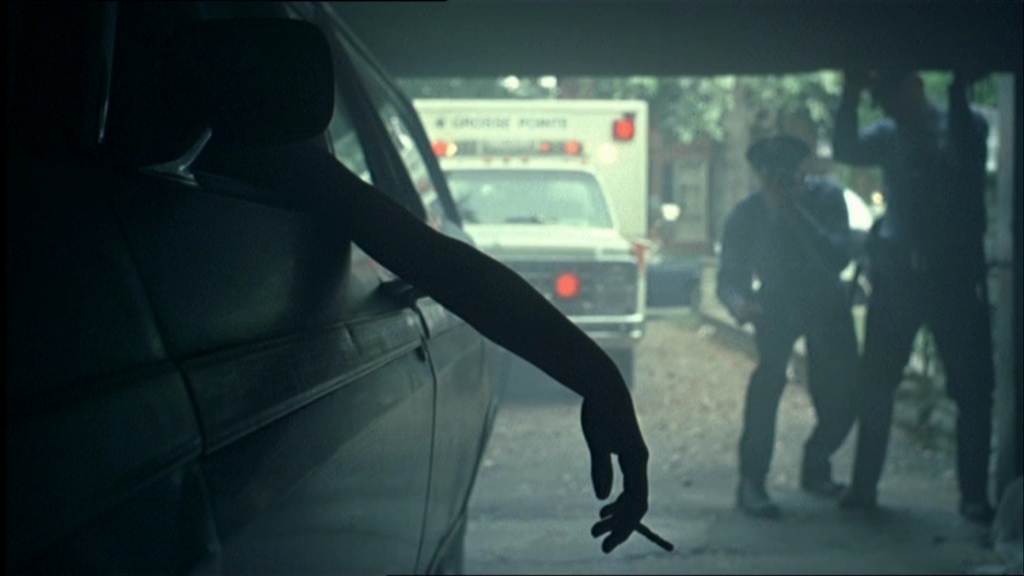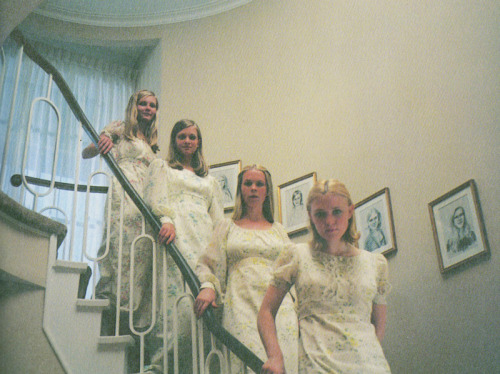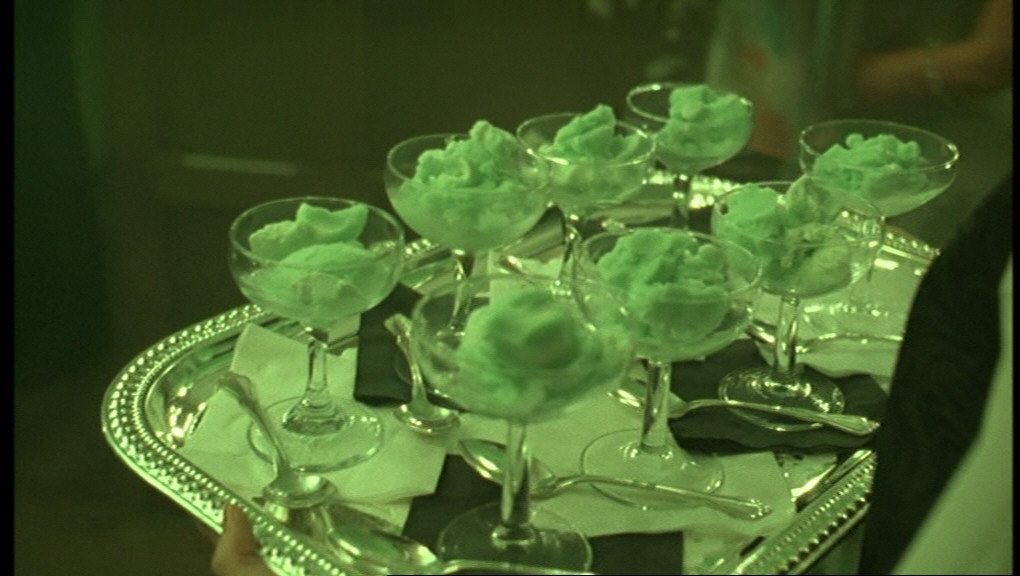To revive my seldom used Media Studies skills I have decided to add a new section to my blog entitled: Mise-en-scene, to unravel what particular shots within various movies, in this case ‘The Virgin Suicides’ reveal about the characters, the tone of the film and its implications. Please do not read if you do not want the film spoilt for you!Cecilia in the tree
Cecilia, the youngest of the Lisbon sisters, is depicted as a melancholy malcontent. She is the first of the sisters to feel deeply discontent with life and ends up committing suicide. After her death, Cecilia haunts the sisters as well as the neighbourhood boys who revered them. The film juxtaposes the childlike fantasies of the girls with their deadening home life. The girls are constantly projecting themselves elsewhere; in dreams, costumes, photographs and in nature.
Here Cecilia is positioned on a tree. She is wearing white which represents purity and innocence but the adorning of her arm with a bracelet and her pose indicate that she is aware of her impending womanhood and all the implications this entails. She is looking upward, as if to suggest that even if this picturesque natural surrounding she is still restless. Her expression is wistful but also slightly bored, as if she is wishing to be somewhere else, but also understands that nowhere can fulfil her. The elm tree she rests on is dying which represents Cecilia’s own longing for, and eventual demise. Cecilia is part of the tree; part of its nature, its poison and its death. Cecilia almost looks like an angel, a bride for God, looking to heaven, bored and unsatisfied with life, and ready to depart. Cecilia is literally embracing her own death.
Cecilia's bracelets
The focus on the film is the death of childhood as we transition into adolescence. For the girls this death is also literal. Here Cecilia sits with her arms bandaged but she has also adorned her wrists with colourful bracelets. The juxtaposition with beauty and pain in the film is almost masochistic. The girls physically, visibly suffer behind the beauty of their belongings and paraphanaelia. Their suffering, which is represented physically by her self-harm, is literally hidden by the adorning of jewellery. She is bound and contained by her suffering. She is not able or free to express it openly. Notice the position of her hands, as if she were there to catch water, only her hands are closed. The colours are muted, soft and feminine – a stark contrast to red blood, further showing the subduing of Cecilia’s despair. Her suffering is literally contained, stifled, repressed and decorated, displayed to the world as a childish error rather than a cry for help.
Sisterhood
Here, Lux, Bonnie, Mary and Therese embrace and comfort one another. The girls are in transition between girlhood and womanhood, a time that is a blur for many culturally and socially. There is no clear definition of when a girl ceases to be a girl and is now a woman. The paraphernalia surrounding the girls echoes childhood: the pinks and the teddy bear on the floor. Lux and Bonnie specifically seek the comfort of their eldest sister Mary, like children, nestling into her. Mary has a knowing and maternal look on her face. Therese in particular is cast aside from the girls, draped suggestively in white like a sacrificial virgin, looking submissive and alert. She is ‘apart’ from the others; she is neither childlike nor maternal. The girls represent three particular states of women: the child, the mother and the whore. This represents the confusion the girls feel about their identities as women in terms of how they see themselves and how they are seen by others.
Lux, the car and the cigarette 
Lux is the last sister to kill herself. In this scene she is found by police whilst a police car and ambulance waits outside. Lux has made the transition from girl to woman. She is in the front seat of the car (possibly the driver’s seat) indicating that she is in charge and has made her own decision. She is clutching a cigarette in a limp hand which is indicative both of the poison in her own nature and the ‘maturity’ of her character. It is also an allude to her method of choice for suicide. Lux is happy to play at being a woman in terms of her promiscuity, but she doesn’t feel truly like a woman, as is evident in her boredom, her whimsy and escapism. The pose of the arm is almost suggestive and sexual, as if she is a grown woman soliciting attention. Lux has been in the dark of the garage but the policeman (male figures) have opened the garage door and allowed light to enter. This might be indicative of Lux’s own awakening as a result of the loss of her virginity to trip, revealing to her another world which her parents refuse to let her into. She has been shut into her childhood, but eventually the light of adulthood will be let in.
Angels on the stairs 
The Lisbon sisters are often depicted as unattainable, asexual and angelic. The boys revere and fantasize about them. They voyeuristically follow the girls, but they never know them. As such, the girls appear aloof, superficial and mysterious. This enables the boy’s fantasies of them to continue. To truly know them might dampen and damage their heightened perception of what the girls are. Here the girls are depicted before their prom standing on their stair way, like angels in heaven. This is exemplified by the sole use of the colour white. The dark rail alludes to the knowing nature that the girls cling to, the one link that binds them and also cements the idea that the girls have embraced death. The girls are not sexualised in this image. They are modestly dressed and appear virginal. Lux is placed at the highest point of the staircase as she is the girl most admired and adored by the neighbourhood boys. Interestingly, ‘Lux’ is Latin for ‘light’.
Cecilia in the bathtub 
Cecilia appears dead, but she has slit her wrists and is lying in the bathtub. She looks tranquil, serene and accepting. The film often depicts life as misery and status and death as peace and freedom. Her gaze is fixed upwards as if she has found what she has been looking for. There is still a slight look of boredom on Cecilia’s face. This is typical of Cecilia, who is a fantasist but is essentially never pleased for very long. She looks like Ophelia, her hair splayed out around her. The blood in the bath is muted and almost pink and also signified the onset of Cecilia’s maturation. The light around her face is a blue white indicating purity but also coldness. The girls have always been seen as beautiful but unattainable. They are shiny veneers, but nobody has stopped to truly understand them.
Surrounding the tree 
This picture is very telling. Again, the sisters look virginal, angelic and modest. They have shackled themselves to one of the local elm trees, which is due to be destroyed as it is contaminated. The girls feel a connection to the trees because they represent the girls own acceptance of and longing for death. The community wants to destroy the trees because they are sick and dying. They do not want the trees to contaminate the neighbourhood. What they do not understand is that the society inhabiting the neighbourhood is also sick. The girls realise this and are not afraid of death, unlike the neighbourhood, who would rather remove the trees than deal with the natural process of their demise.
Lux on the football field 
Shortly after Lux loses her virginity to Trip after the prom, he abandons her on the football field. He later explains that he truly cared for Lux, but at that precise moment could not stand to be around her. He regrets that he was never able to tell her how he felt. The colours used are white, pink and blue. The colours are very muted as dawn emerges. Lux has woken up a new woman. She is literally no longer a child, in body or in mind. She has had her first experience of sex, disappointment and betrayal. This cements her own understanding life as a contaminated thing. She is lying on deadened grass on the football field (the traditional domain of men). She is still wearing her prom dress with the flower pinned to it. She is turning away from the camera, wistfully looking upward. The tone of the picture is melancholic. Lux looks vulnerable but also liberated. She has learnt that their love is crueller and colder than she expected. She now understands what her parents tried to shield her from, as much as she resents it. She is wizened by her first experience of love, betrayal and abandonment. Lux perhaps has a different incentive to the other sisters for suicide; she has learnt that she will be perceived as a fantasy object or as a sexual plaything; either the Madonna or the whore. As she does not see herself is either, she is forced instead to reject these inferences, removing herself altogether.
First love
Before Lux is betrayed by Trip, the two look like a fairytale couple. Lux is again looking upward, but this time not to the heavens, but into Trip’s eyes. Lux is dressed in white (again, virginal and innocent) and Trip in black symbolising experience but also corruption (his own corruption and his ‘corruption of Lux’). Again Lux means light, and Trip is the dark force that impedes her childlike existence and shows her the world she and her sisters are being protected from. We can visibly see Lux, after all, we are always voyeurs to the sister’s story, but Trip is hidden from us; unknown, deceptive and shady. The background is muted white and blue, looking like a starry night, but also warning us of the unhappy ending to the couple’s puppy love.
Surprise!
Death in this film is always shown as an escape or as something to be celebrated. Here Bonnie hangs herself, but she is dressed for the occasion and the room is strewn with party items, indicating that her death is more of a party than a tragedy. Of course, the imagery clashes horrifically with the family’s loss of their five beautiful daughters, but for the girls themselves, this was a premeditated plan with the intention to be liberated from the shackles of their family, religion and the expectations they have been entrenched in since birth.
Dreaming of Lux
Here, Lux is remembered by the neighbourhood boys. She and her sisters are immortalised by them. Lux is still depicted as an angelic thing, breaking through the summer sky amidst the puffy white clouds. She winks at the boys suggestively and teasingly. It is this contrast of innocence with maturity that the girls come to represent as if they know secrets that no-one else does. The faded essence of Lux implies that she is a memory, a fantasy – not a flesh and blood thing, and that the whole thing has always been a game.
Lux and the unicorn 
The boys remember the girls through a filter. They envision them as fairytale things, similar to unicorns, the girls that the boys want can never really exist. Here Lux is faded again (she is still a dream/fantasy) and she is suggestively dressed. She represents joy, freedom and virility. This is the Lux that Lux wants to be (free) but also the Lux that the boys want (an intriguing mixture of innocent and sexual). She is mythologized beside the unicorn indicating the impossibility and naivety of their desire for her to be what they want. Lux can never be their fantasy thing. In death, she has become cemented as an idealised creation always available to them in their dreams. The sisters are as much an escape for the boys, as death is for the girls.
Girlhood items 
Tellingly the girl’s belongings represent a clash of religious imagery and beauty products. The crucifix is pronounced and hangs over a perfume bottle like a noose representing the girl’s suffocation and guilt at being women. The items are chaotic and cluttered. Most of the items are coloured white and blue for purity, but the red nail varnish and amber bottles indicate a more sexual and attention seeking element. The products represent awareness of femininity, beauty and sexual appeal (highlighted further by the freedom represented by the birds) stifled or repressed by the religious icons, which evoke a sense of confusion and sin.
Cecilia's diary 
The boys know the girls through Cecilia’s diary entries. They imagine her writing in a cornfield. Cecilia embodies escape and a desire for freedom. She is not enamoured with the physical world. Cecilia is often perceived in nature where she can be a natural thing, and not a construct. The golden colour highlights the sense of fantasy and nostalgia surrounding her.
Sickness, anyone?
Green desserts and a green camera hue represent society’s sickness. The film focuses on the obsession with happiness at all costs and the inability to understand misery and mental illness. The green colour is a stark contrast to the earlier peaceful hues used, indicating that the neighbourhood is growing sicker, the contamination is here to stay and society is gorging itself on sickness.
Finger in the water 
One of the girls has thrust her finger into a small tank of water, possibly housing sea monkeys. The hand itself is adorned with a ring, almost as if the child is a bride. The book below the tank reads ‘Sacred will of sacrifice’. The girl’s death is a preservation of themselves; their innocence, beauty and youth. Water is often associated with the unconscious and with femininity. The link between the girl and the world beneath the water suggests an understanding of her own subconscious mind (at the very bottom the need for sacrifice) and an acceptance of this, on her own terms. It also represents the effect of a penetrating outside force shifting the dynamic of a self-contained world. The girls own external experiences cause them to feel desperately unhappy in the stifling stasis of their childhood home.




















